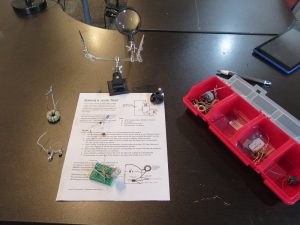
This last Sunday, for our first Castlemakers Kids meeting of the year, eight kids (and a few adults) learned about the electronic circuit called the “Joule Thief.” It’s a fun circuit that has gained some popularity in hacker circles, yet a lot of people don’t know about. Two factors make it a good kids project: The simplicity of the circuit and you don’t need to understand the electronics behind it. For inquiring minds it can challenging because it’s not immediately obvious how it works.

The name is based on getting extra energy (joules) out of dead batteries. Or at least batteries that most people think are dead. The circuit, with only 4 components, can use as little as .5 volts from a single dead cell AA battery and boost it up over 3 volts – more than enough to light up a white or blue LED. Even a brand new 1.5 volt AA battery won’t do that! For the more technically minded it’s a simple blocking oscillator (IMHO not an Armstrong since there’s no capacitor) that pulses higher voltage using a inductor, resistor, and a transistor.
There are lots of different ways to make the circuit, which turned out to be part of the fun. We tore apart computer power supplies to get the toroid coils, but also experimented using parts from burned out Compact Fluorescent Light (CFL) bulbs too. We found out the CFL parts worked great & possibly how we’ll do it in the future – although it can be tough to wind the toroid from some of the newer CFL bulbs. One future experiment – the Joule Thief circuit can charge dead rechargeable batteries, another great way to get energy out of supposedly dead batteries!